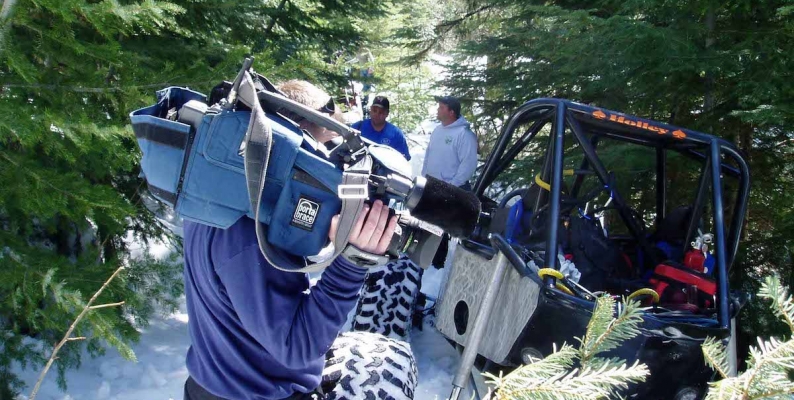
Rodeo competitor Laynee Gregerson outside the College of Southern Idaho Expo Center on March 21, 2015 in Twin Falls, Idaho.
Photo by Stephen Reiss
Editor’s Note: Stephen Reiss is the winner of this year’s Don Watkins Mid-Career Scholarship from the Idaho Press Club, which he is using to help defray the expenses for a long-form enterprise photo story based around specific aspects of water in the Magic Valley. The project will include a multimedia collage of images, sound and video that will be the culmination of the thematic photo essay. Here, Reiss shares what he’s learning as he works on the project.
By Stephen Reiss
Idaho’s Magic Valley gets its name from a transformation that took place at the turn of the 20th century, when its founders dammed the Snake River and converted a high desert into some of the most productive farmland in the region. Today a series of irrigation canals form a delicate latticework of arteries and veins, furnishing the valley with water as communities grow in the wake of agricultural development.
The project “Sweethearts” is a photographic study of the communities that have grown along the Snake River. At a time of expansion and drought, the residents of the valley are inextricably linked to the land and the limited lifeline of its water stores. In the desert, water is the valley’s circulatory system, and the Snake its beating heart.
This relationship can be traced to the birth of the Magic Valley in 1900, when I.B. Perrine incorporated the Twin Falls Land and Water Company, and filed notice with the state for the diversion of water on both sides of the Snake River. He contracted with the state to develop 270,000 acres under the new Carey Act, allowing for private enterprise to develop irrigated tracts, and sell land and water rights. Milner Dam was completed by 1905 to divert the water, which was first sent to the Twin Falls Tract on the south side of the Snake River through a canal. Later, canals were built on the north side of the Snake to irrigate the 185,000 acre North Side Tract.
The Twin Falls project, North Side Project, and ensuing Minidoka Dam were the first examples in the country of irrigation waters provided by the U. S. Reclamation Service merging with private and state water resources to develop large irrigated tracts. It was these developments that transformed the Magic Valley desert into the center of Idaho’s agribusiness industry.
According to a report by the University of Idaho, in 2010 total output from the Magic Valley economy exceeded $14 billion. Magic Valley’s gross regional product was $5.5 billion with a total of 88,700 jobs. Magic Valley agribusiness sold more than $7 billion of goods and services, contributed $3.4 billion to Idaho’s gross state product and created over 15,000 jobs. The largest industry in the Magic Valley is dairy processing, contributing over $4 billion to the Magic Valley economy. Idaho is the third largest dairy state in the nation, and 70 percent of those cows are in the Magic Valley. Potato processing is the fourth largest industry with base sales of $1 billion.
Travelling through the communities along the Snake River, the importance of irrigation and agriculture permeates all facets of society. You see it on the faces of the farmers in the fields and pastures that dominate the landscape, you see it on the mud caked cowboy boots at the county fair, and you most vividly see it from the air. From the seat of a Piper Cub airplane, the sight of Milner Dam and the miles of braided irrigation canals put the region’s dependence on the Snake River into focus.
According to the United States Drought Monitor Report, most of Idaho is now in a drought or heading into drought. This compared to May 2014, when half of Idaho qualified as under some sort of drought condition. If precipitation does not increase this year, the state could face a crisis in 2016. As reported by the Idaho Statesman, this year senior water users in the Magic Valley, who receive their water directly from rivers or springs, have demanded that users who get their water by pumping it from the ground give them 89,000 acre-feet of water or leave some lands idle.
While this is not the crisis-portending drought that California is currently enduring, it highlights the Magic Valley’s reliance on its water stores to support its current growth. I feel fortunate to be documenting this community during this productive time. I feel most comfortable walking around with my camera behind the scenes at a tractor pull in Shoshone, following farmers and ranchers as they tend to their land and livestock in Hansen, or simply photographing the view at dusk from the Perrine Bridge in Twin Falls. These are communities on the edge, caught in a period of upward transition, and there couldn’t be a more exciting time to document it.
Stephen Reiss is a staff photojournalist at the Twin Falls Times-News, and is this year’s Idaho Press Club Don Watkins Memorial Mid-Career Scholarship winner. The scholarship, which provides $500 for professional development or a special project that will improve the working press in Idaho, is awarded annually; the deadline to apply is Feb. 15.

